
During the December 4, 2002 Total Solar Eclipse
 |
Predicting
the Structure
of the Solar Corona During the December 4, 2002 Total Solar Eclipse |
|---|
On Wednesday, December 4th, 2002, a solar eclipse will be visible in the southern hemisphere. Within a narrow corridor crossing southern Africa, the Indian Ocean, and southern Australia, a total eclipse (lasting a maximum of 2 minutes 4 seconds) will occur. A partial eclipse will be visible over approximately two thirds of Africa, Antarctica, the Indian Ocean, and Australia. To see a detailed description of the eclipse path, please visit Fred Espenak's 2002 Solar Eclipse web site.
On 26 November, 2002, we initiated an MHD computation of the solar corona, in preparation for our prediction of what the solar corona will look like during this eclipse. We used photospheric magnetic field data from Carrington rotation 1995 (corresponding to the dates October 6 - November 3, 2002) from the National Solar Observatory at Kitt Peak. Subsequently, we updated the magnetic field data in the simulation with the latest data available on November 27, 2002, and again on December 1, 2002. The eclipse prediction, based on this simulation, is shown below. (Please note that this prediction may change slightly as late as the day before the eclipse, since we may update this page from the latest results of the calculation.) Preliminary results showing the magnetic and plasma properties of the solar corona and inner heliosphere during this time period can also be obtained from our new modeling web site. (These resources are still in beta-testing, and so should be viewed with caution).
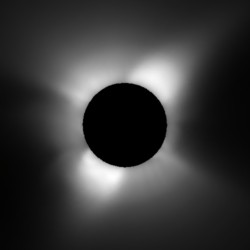 |
The figure on the left shows the predicted polarization brightness (pB) in the solar corona for the eclipse expected on 4 December, 2002 at 06:00UT (corresponding to totality in Angola). The state of the solar corona was computed using a 3D magnetohydrodynamic (MHD) simulation. The pB signal is produced by white light scattered off electrons in the coronal plasma. The image has been radially detrended to account for the fall-off of coronal brightness with distance from the Sun. Vertical (top) is terrestrial (geocentric) north. This is the view of the Sun that would be seen by an observer on Earth with a camera aligned so that vertical is toward the Earth's north pole. To view this image in a coordinate system aligned with solar north, click here. Click the image to see it in more detail. |
|---|
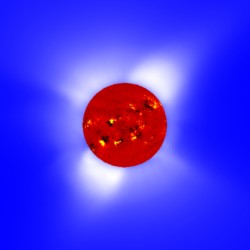 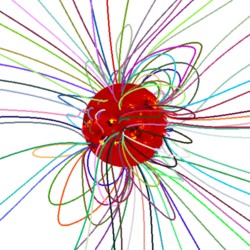 |
| Predicted polarization brightness (top left) together with traces of the magnetic field lines in the solar corona (top right) for the eclipse expected on December 4th, 2002 at 06:00UT (with terrestrial north up). The Sun's surface shows color contours of the radial component of the measured photospheric magnetic field from Kitt Peak National Solar Observatory, showing the location of active regions (strong magnetic fields). Click the images for higher resolution pictures. To view these images in a coordinate system aligned with solar north, click here. |
|
(a) Image from South Africa
(courtesy of Wendy
Carlos*) |
Polarization Brightness |
and Coronal Hole |
(d) Composite of a LASCO C2 Image and an EIT Image** |
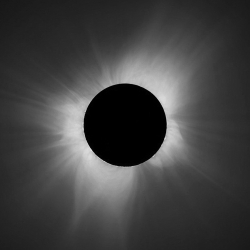 |
 |
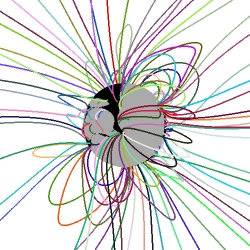 |
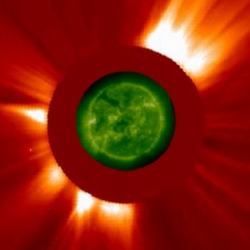 |
From left to right: (a) an eclipse image taken in Messina, South Africa. The eclipse image is a computer composite and optimization from several negatives taken by Wendy Carlos, merged with images taken with radially graded filters by Jonathan Kern. (b) the predicted polarization brightness from the MHD model. (c) the magnetic field (colored lines) and estimated coronal hole (black) from the MHD model (d) A superimposition of the EIT emission (green) and LASCO C2 image (orange) close to eclipse time. In the figures above we compare our MHD model prediction with a photograph taken in South Africa. The images have terrestrial (geocentric) north vertically upward.
*Eclipse Image: © 2002 Wendy Carlos and Jonathan Kern - All Rights Reserved. For details, see http://www.wendycarlos.com/eclipse.html and http://www.ligo-la.caltech.edu/~jkern/Eclipse02/.
**Courtesy of the SOHO/EIT & LASCO consortia. SOHO is a project of international cooperation between ESA and NASA.
| The photospheric magnetic field maps we use for our
calculations are
built up from daily observations of the Sun during a solar rotation.
These maps give a good approximation of the Sun's magnetic flux if the
large-scale flux is not changing much throughout a rotation.
Previously,
we have computed coronal models for an eclipse during the declining
phase
of the last solar cycle (November
3, 1994), for two eclipses during solar minimum (October
24, 1995 and March
9, 1997), one eclipse during the the early rising phase of solar
cycle
23 (February
26, 1998), one eclipse approaching solar maximum (August
11, 1999), and one eclipse at solar maximum (June 21, 2001).
The December 4th, 2002 eclipse, although occurring approximately one
year after the peak of solar maximum, presents a significant challenge.
The photospheric magnetic
field is evolving rapidly, making synoptic magnetic field data a less
reliable approximation to the true state of the photospheric magnetic
field.
These figures show the photospheric magnetic field maps for three Carrington rotations, CR1995, CR1995+1996, and CR1996+1997, as measured by the National Solar Observatory at Kitt Peak. The maps show the measured photospheric magnetic field as a function of latitude (vertical axis) and Carrington longitude (horizontal axis). Red shows outward directed magnetic flux, and blue shows inward directed flux. Click the images for higher resolution pictures. These maps are considerably more complex than maps during solar minimum. |
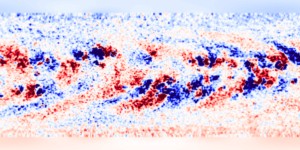
|
If your movie player can continuously loop a movie
while
playing it, set this option to "on" for the best effect. For example,
on a Silicon Graphics machine, you would use the execute line:
movieplayer -l 0 cr1996.mpg
Z. Mikic, J. A. Linker, D. D. Schnack, R. Lionello, and A. Tarditi, "Magnetohydrodynamic Modeling of the Global Solar Corona," Physics of Plasmas, 6, 2217 (1999).Z. Mikic, J. A. Linker, P. Riley, and R. Lionello, "Predicting the Structure of the Solar Corona During the 11 August 1999 Total Solar Eclipse," in The Last Total Solar Eclipse of the Millennium, Proceedings of the Conference held in Istanbul, Turkey, 13-15 August, 1999 (W. Livingston and A. Ozguc, eds.), ASP Conferences Series, Vol. 205, p. 162 (2000).